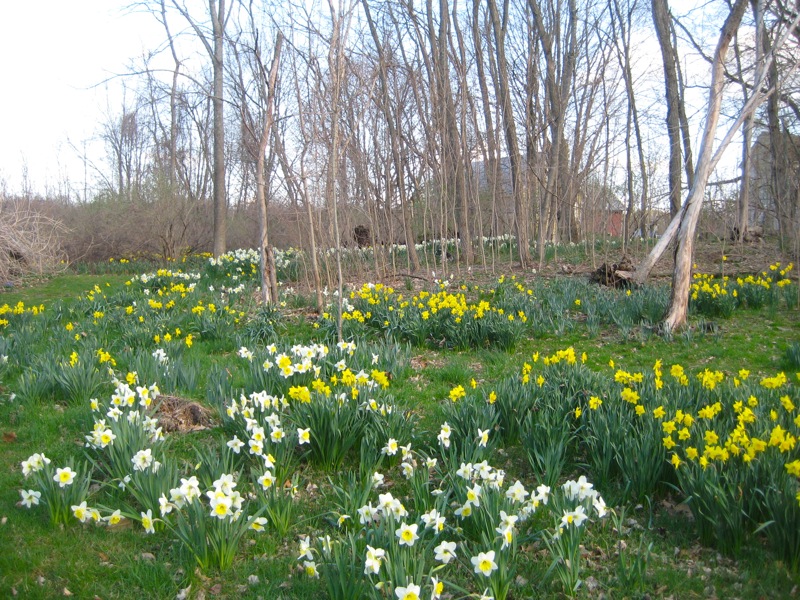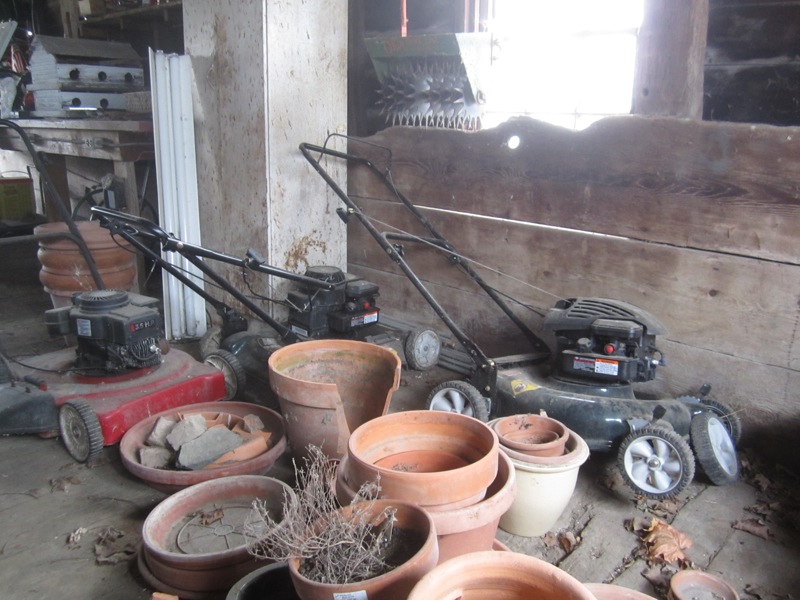shifted my attention the very edge of the woods. A few fern, and a clump of daffodils were the first pioneers on the fringe of that dark untamed corner of my property. Encouraged by the daffodils thriving under my benign neglect, I began to plant more, year by year. Eventually the whole edge of the woods and roadside on the southern part of my property began spring on a bright note. After time, I decided to take another cautious stab at the woodland garden, encouraged by three factors.
- My Scary Neighbor died
- The Elm Trees died
- 3 Lawnmowers died
The first, my neighbor’s death, is more a footnote to the previous story. I never saw him again after our initial meeting. I began to think he was a ghost, or a hallucination produced by drinking the unfiltered water from our well, but one day I was relating the story of our meeting and another (friendlier) neighbor, who said
“Yep, Jack was little tetched, as they say”, pointing to his temple. “Died not long after moving back here”.
Don’t get me wrong, anyone’s death saddens me, but it sounded as if my neighbor had passed some years before, and I wore enough black in those days to cover a decent mourning period, so I have to say there was a sense relief that I would now be able to prune my woods with impunity.
The part of the woods closest to the lawn consisted primarily of a stand of young and adolescent elm trees so thick, that in the summer they created an almost impenetrable screen. Over time, some of the elms began to look sick, and the next year, look dead. The blight moved through the stand at about 10 to 15 feet each year. I assumed it was Dutch Elm disease. Of course I am not certain of that, but as the Dutch take the rap for so little these days, I am sure they don’t mind my blaming a few dead trees on them. Some fell over, some I pushed over, and my handy man sawed a few down, the rest still stood as stick sentinels in my woods. Their absence created some sunnier gaps in the woods, and while sad to see them go, I belong firmly to the “life’s lemonade” school. I liberally dosed any poison ivyish looking plants growing in the sunny spots with round up, and planted daffodils there in the fall. Bolstered by there continued success, began to plant between three and five hundred each autumn, and within time, the daffodil woods became a very pleasing site in spring, and only in spring, that is.

The dying lawnmowers were the bane of my existence for a brief period. The daffodils appreciated the open light of my elm free woods, but so did the invasive wild roses, and baby red maples. I tried pruning them as they grew up, as I liked the idea of tall grass growing under the trees. It certainly did, along with burdocks and untold other plants with hooked seedpods that stuck to my clothes and got tangled in my dog’s hair. I asked my lawn guy, Angel to start mowing the open areas of the woods in July, after the daffodil greens turned yellow.
“No”, was his reply, “too many stumps”.
Annoyed by his lack of helpfulness, I bought a walk behind mower to cut the woods myself. I worked like a charm – until the blade hit a low stump, which bent the lawn mower’s shaft. Apparently lawn mowers are fairly easy to fix, (if I was in any way remotely mechanically inclined), but I discovered a bent shaft renders a lawnmower useless. To get around that first challenge, I bought another mower, and set the wheels at the highest setting, to clear any low lying stumps. I bent the shaft on that one on one of the higher stumps. Undaunted, I bought a third. I should have christened it Goldilocks, because it found a stump not too tall, not too short, but just right, to bend its shaft on. Now was I was daunted. The three dead mowers sat in my barn. I asked my handyman Jim to take their carcasses to the lawnmower graveyard, wherever that was.
“No” was his reply, amazed by my ignorance of the assets I possesed. “Do you know how many good spare parts are on the mowers?”.
“Well,” I answered, in my best this your lucky day voice, “ Tell you what, you can have them for the spare parts, because I like you.”
“Thanks” he said, touched. “I’ll take them, but if it’s ok with you, I will keep them in your barn, Mary (his wife) would kill me if I brought another broken lawnmower home”.
Knowing when to pick my battles, I let him have that one. The three dead mowers sit in my barn to this day. Their spare parts untouched for the most part, although a wheel has been taken off of one. It wasn’t used for anything else, because it is still sitting there, just taken off.
Last year I decided before breaking any more mowers to join the trio in my barn, to bite the bullet and pay a tree service to clear out of the dead trees, red maple saplings and the roses. In addition to hiring someone with a stump grinder to get the stumps down to a mower friendly level, there is another reason for this. I am not too good with chain saws. One in my hands would be a dangerous thing. Actually, it probably wouldn’t even stay in my hands that long, as they would be amongst the first things I would most likely cut off. Hugh, who I hired to clean out a portion of the woods, was great. He even ran the smaller trees through a wood chipper, producing enough chips for an eighteen-inch deep path that I ran about 75 feet.
I was thrilled with the newly cleared area. One day I came across a lone surviving Japanese fern I had planted almost a decade earlier. Like a marooned Japanese pilot discovered on a remote desert island in the Pacific decades after WW2, I tried to think of the best way to let him know the war with the woods was over. With some large scale clearing done, a strong spring start with my daffodils, mature locusts and some maples to serve as a woodland foundation, and the potential for bent shaft-tree grooming, I was ready to begin thinking about planting some flowering trees and shrubs in this part of the property. Where to begin though? Fortunately for me, along came Irene.
Hurricane Irene, that is. Amongst the upstate towns that were overwhelmed by Irene’s floodwaters, was Schoharie, where one of my favorite resources for plants Guernsey Schoharie Nurseries, ( http://www.schoharienurseries.com/ ) is located. They have a great selection, and far enough away from the Hudson Valley nurseries to be very reasonably priced. I usually pick up plants on sale there each fall. I assumed, somewhat correctly, that their stock had been swept away by the 6-foot floodwaters and resigned myself to no new plant material last fall. However, driving through the town on my way home from my mother’s in Oneonta one weekend, I saw a hand painted sign amongst the debris they were clearing out. They were still open, and had salvaged some of their stock, which they were getting rid of at fire sale prices. Mud encrusted and stripped of foliage, they definitely looked worse for wear, but priced at either $5 or $10, they were worth the risk to me. I picked up (amongst plants for other parts of my garden) a redbud, a cherry and two kousa dogwoods. In late October, I planted the redbud and cherry on the sunny southern edge of the woods, and the kousa close to the locusts and ash. They certainly looked forlorn, particularly the dogwood, which had been stripped of all smaller branches and looked not unlike the gnarled posts I had tried build a rustic fence around a decade before. In March, after the winter rains had washed off the mud, I was initially left with what appeared to be four dead looking trees. It is April now. The cherry seems to be taking off. The redbud looks and appears dead, but still has a little pliability to it, which I am taking for a signal not to give up on it yet (I have named it Sunny von Redbud, and hope for a miracle). One of the two kousa sticks has sprouted several leaves. I am optimistic.
 Sunny von Redbud and a portion of the path created from Hugh's chippings.
Sunny von Redbud and a portion of the path created from Hugh's chippings.

